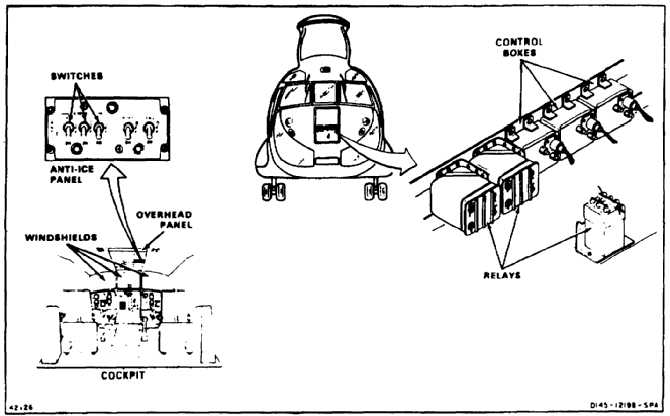TM 55-1520-240-23-10
12-1
WINDSHIELD ANTI-ICING SYSTEM
12-1
DESCRIPTION
The windshield anti-icing system operates independently
on the three cockpit windshields. The pilot’s and copilot’s
windshields have anti-icing and anti-fogging systems.
The center windshield has an anti-fogging system only.
NO BREAK - WORK HARDER
The total system consists of the three windshields,
three switches on the overhead panel, and three relays
and control boxes behind the nose dynamic absorber.
Each windshield is made of laminated layers with an
embedded temperature sensor. The inner surface of the
outside layer is a transparent heating element. When
the switch is operated, current passes through the
transparent element, heating the windshield.
NO BREAK - WORK HARDER
Electrical circuits for the three windshields are identical,
except that the cut-in temperature for the center
windshield is lower.
THEORY OF OPERATION
When any of the windshield switches on the ANTI-ICE
overhead panel is moved to ON, 28 vdc is applied to the
temperature controller for the associated windshield.
If the temperature of the windshield, as sensed by
an imbedded sensor, is below 90ºF (32ºC) (pilot’s or
copilot’s windshield) or 80ºF (27ºC) (center windshield),
relay K1 in the controller is energized, applying 115 vac
to the heating element in the windshield.
NO BREAK - WORK HARDER
As windshield temperature increases, resistance within
the sensor also increases. When the temperature
reaches 110ºF (43ºC), sensor resistance is high enough
to reenergize the anti-ice power relay, cutting off power
to the heating element. When the windshield cools, the
sensor reenergizes the relay and current flows again to
the heating element.
NO BREAK - WORK HARDER
Power for the pilot’s and center windshield comes from
the No. 2 ac bus. Power for the copilot’s windshield
comes from the No. 1 ac bus. Temperature control of
the pilot’s and center windshield is through the No. 2
dc bus. Control of copilot’s windshield temperature is
through the No. 1 dc bus.
12-2

